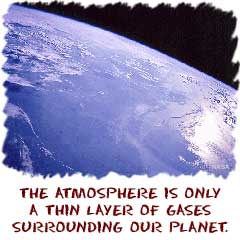Up in the Sky
 What is the sky? What is air? What is the atmosphere? The atmosphere is a thin layer of gases that surrounds the Earth. It seals the planet and protects us from the vacuum of space. It protects us from electromagnetic radiation given off by the Sun and small objects flying through space such as meteoroids. Of course, it also holds the oxygen (O2) we all breathe to survive.
What is the sky? What is air? What is the atmosphere? The atmosphere is a thin layer of gases that surrounds the Earth. It seals the planet and protects us from the vacuum of space. It protects us from electromagnetic radiation given off by the Sun and small objects flying through space such as meteoroids. Of course, it also holds the oxygen (O2) we all breathe to survive.
In the same way that there are layers inside of the Earth, there are also layers in the atmosphere. All of the layers interact with each other as the gases circulate around the planet. The lowest layers interact with the surface of the Earth while the highest layers interact with space. On your level, you may feel the atmosphere as a cool breeze. Other times you will feel it as a hot or humid day that seems to push on you from all sides.
An Envelope of Gases
When compared to the diameter of the Earth, the atmosphere is very thin. The thickness of the atmosphere is a balance between the gravity of the Earth and energetic molecules that want to rise and move towards space. The molecules in the upper layers of the atmosphere become excited as energy from the Sun hits the Earth. The molecules in the lower layers are cooler and under greater pressure.If the Earth were larger, the atmosphere would be denser. The increased mass and related gravity of a larger planet would pull those gas molecules closer to the surface and pressure would increase.
The atmosphere is more than just layers of gases surrounding the planet. It is also a moving source of life for every creature of the planet. While the majority of the atmosphere is composed of nitrogen (N2) molecules, there are also oxygen and carbon dioxide (CO2) which plants and animals need to survive. You will also find ozone (O3) higher in the atmosphere which helps filter harmful ultraviolet radiation from the Sun. The atmosphere also protects us from the vacuum and cold of space. Without our atmosphere, the Earth would be as barren and dead as the Moon or Mercury.
Connecting Climates
 There is no single climate of the planet. Specialized climates are found in areas all over the planet and might include deserts, rainforests, or polar regions. The common trait of all of these climates is the atmosphere. The atmosphere circulates gases and particles between all of these regions.
There is no single climate of the planet. Specialized climates are found in areas all over the planet and might include deserts, rainforests, or polar regions. The common trait of all of these climates is the atmosphere. The atmosphere circulates gases and particles between all of these regions.
The hot air from the equator eventually moves north or south to other climate regions. That warmer air combines with cooler air, mixing begins, and storms form. The constant mixing of the atmosphere maintains a stable system that helps organisms survive. Oxygen will never run out in one area of the planet and temperatures will not skyrocket in another. The atmosphere balances the possible extremes of the Earth and creates an overall stability.
A great example is seen in the way tropical cyclones (hurricanes) form over the Atlantic Ocean. Because of global atmospheric circulation, systems start over the Sahara Desert in Africa, move across the west coast of northern Africa, pick up large amounts of water as they pass over the warm Atlantic Ocean and Caribbean Sea, and finally dump all of the rain on the Caribbean or south eastern coast of the United States. In addition to the stormy weather, the atmosphere can also carry dust and particles from the Sahara to North America.
Or search the sites for a specific topic.
- Overview
- Composition
- Temperature I
- Temperature II
- Pressure
- Circulation
- Interaction
- Coriolis Force
- Greenhouse Effect
- More Topics

Earth’s Atmosphere (NASA Explorer Schools Video)

Useful Reference Materials
Encyclopedia.com:http://www.encyclopedia.com/topic/atmosphere.aspx#3
Wikipedia (Earth's Atmosphere):
http://en.wikipedia.org/wiki/Atmosphere_of_Earth
Encyclopædia Britannica:
http://www.britannica.com/EBchecked/topic/41364/atmosphere





